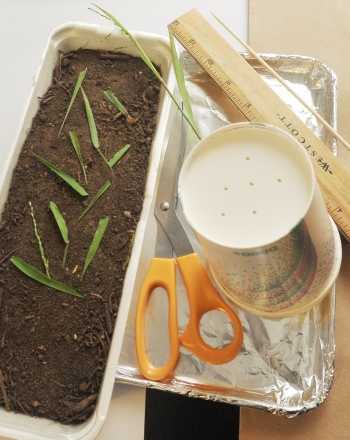
Cargando...
¿Qué puedo hacer?
226293 materialEducativo
textoFiltroFichatipo de documento Biología - Experimento/Práctica
Acerca de este recurso...

Grass might not be the most exotic looking plant in the world, but it is one of the most important. Its pretty green color comes from the chlorophyll inside, which is a pigment that plants use in photosynthesis. Photosynthesis is the process in which plants convert light energy from the sun to chemical food energy, and chlorophyll is essential to the first steps of that process. Grass plants store the food energy, and when grazing animals like buffalo, deer, or cows eat the grass. If you eat beef or drink milk, you are getting energy from the sun that was originally stored as food energy by grass!Grass is also important because it reduces the erosion of soil. Erosion involves the carrying away of earth by water, ice, and wind. Soil can take millions of years to form, so we certainly don’t want it carried away, and humans have spent years learning how to prevent erosion. In this experiment, you are going to see how the presence of grass affects the rate of erosion, but first you need to learn a bit more about the structure of grass.Grass belongs to the herbaceous plant group, which consists of plants that have soft stems—not tough ones like woody plants have. Grass plants also have fibrous roots, meaning they don’t have a big central root like a carrot plant does. Instead, their roots spread out in all directions.Below is a diagram of the grass plant. Note the soft central stem and the attached leaves. The place where the grass leaves attach to the stem are called the nodes. Besides having regular vertical stems, grass plants have horizontal stems. If the horizontal stem grows above the ground, it is called a stolon or runner, if the horizontal stem grows below the ground, it is called a rhizome. Sometimes, instead of starting from a seed, new grass plants grow from stolons or rhizomes.
It is an educational content by education.com.
By clicking on the title of this resource, you will be redirected to the content. If you want to download the project, you just have to join the website, which now is for FREE.
Contenido exclusivo para miembros de

Mira un ejemplo de lo que te pierdes
Autores:
Categorías:
Fecha publicación: 12.5.2016
Se respeta la licencia original del recurso.
¿Quieres comentar? Regístrate o inicia sesión
Añadir a Didactalia Arrastra el botón a la barra de marcadores del navegador y comparte tus contenidos preferidos. Más info...
Comentar
0